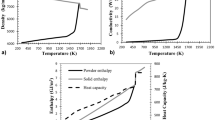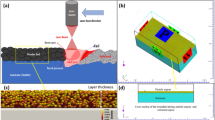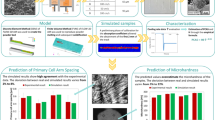Abstract
Laser powder bed fusion (LPBF) is a subset of the additive manufacturing process in which a laser beam selectively joins the metal powder into a desired part in a sequential layer process. Owing to its complex nature of rapid heating and cooling of the melt pool, there is a need to understand the melt pool behavior and its effects on the final manufactured part. A densely packed powder bed is highly desirable for fabricating a superior part using the LPBF process. In this work, discrete element model was used to generate powder beds with realistic powder properties and various factors affecting the packing density were studied. The powder beds generated were then irradiated with a high-power laser source to selectively melt the powder particles to study the melt pool dynamics using volume of fluid method. The effect of laser parameters like laser power and scan speed on the melt pool was studied using single-track and multi-track simulations. Multi-layer simulations were performed to replicate the actual LPBF process. The simulations were in close agreement with actual experimental efforts.






















Similar content being viewed by others
Data availability
The data that support the findings of this study are available from the corresponding author upon reasonable request.
References
ASTM (2012) ASTM F2792–12a: standard terminology for additive manufacturing technologies. ASTM International, West Conshohocken, PA
Gu DD, Meiners W, Wissenbach K, Poprawe R (2012) Laser additive manufacturing of metallic components: materials, processes and mechanisms. Int Mater Rev 57:133–164. https://doi.org/10.1179/1743280411Y.0000000014
Markillie P (2012) A third industrial revolution. The Economist 21. https://www.economist.com/node/21552901
Zhang M, Zhang B, Wen Y, Qu X (2022) Research progress on selective laser melting processing for nickel-based superalloy. Int J Miner Metall Mater 29:369–388
Vandenbroucke B, Kruth JP (2007) Selective laser melting of biocompatible metals for rapid manufacturing of medical parts. Rapid Prototyp J 13:196–203
Herzog D, Seyda V, Wycisk E, Emmelmann C (2016) Additive manufacturing of metals. Acta Mater 117:371–392
Yablokova G, Speirs M, Van Humbeeck J, Kruth J-P, Schrooten J, Cloots R, Boschini F, Lumay G, Luyten J (2015) Rheological behavior of β-Ti and NiTi powders produced by atomization for SLM production of open porous orthopedic implants. Powder Technol 283:199–209
Gong X, Anderson T, Chou K (2014) Review on powder-based electron beam additive manufacturing technology. Manuf Rev 1:1–12
Dawes J, Bowerman R, Trepleton R (2015) Introduction to the additive manufacturing powder metallurgy supply chain. Johns Matthey Technol Rev 59:243–256
Spierings AB, Voegtlin M, Bauer T, Wegener K (2016) Powder flowability characterization methodology for powder-bed-based metal additive manufacturing. Prog Addit Manuf 1:9–20
Calignano F, Manfredi D, Ambrosio EP, Biamino S, Pavese M, Fino P (2014) Direct fabrication of joints based on direct metal laser sintering in aluminum and titanium alloys. Procedia CIRP 21:129–132
Yuan P, Gu DD, Dai DH (2015) Particulate migration behavior and its mechanism during selective laser melting of TiC reinforced Al matrix nanocomposites. Mater Des 82:46–55
Simchi A (2006) Direct laser sintering of metal powders: Mechanism, kinetics and microstructural features. Mater Sci Eng A 428:148–158
Shi YJ, Shen H, Yao ZQ, Hu J (2007) An analytical model based on the similarity in temperature distributions in laser forming. Opt Lasers Eng 45:83–87
Li Y, Gu DD (2014) Parametric analysis of thermal behavior during selective laser melting additive manufacturing of aluminum alloy powder. Mater Des 63:856–867
Körner C, Attar E, Heinl P (2011) Mesoscopic simulation of selective beam melting processes. J Mater Process Technol 211:978–987
Wei ZYP, Wei Z, Chen Z, Du J, He Y, Li J, Zhou Y (2017) The AlSi10Mg samples produced by selective laser melting: single track, densification, microstructure and mechanical behavior. Appl Surf Sci 408:38–50
Meier C, Penny RW, Zou Y, Gibbs JS, Hart AJ (2017) Thermophysical phenomena in metal additive manufacturing by selective laser melting: Fundamentals, modeling, simulation and experimentation. Annu Rev Heat Transf 20:241–316. arXiv:1709.09510
Sames WJ, List FA, Pannala S, Dehoff RR, Babu SS (2016) The metallurgy and processing science of metal additive manufacturing. Int Mater Rev 61:315–360. https://doi.org/10.1080/09506608.2015.1116649
King WE, Anderson AT, Ferencz RM, Hodge NE, Kamath C, Khairallah SA, Rubenchik AM (2015) Laser powder bed fusion additive manufacturing of metals; physics, computational, and materials challenges. Appl Phys Rev 2:1–26. https://doi.org/10.1063/1.4937809
Patil RB, Yadava V (2007) Finite element analysis of temperature distribution in single metallic powder layer during metal laser sintering. Int J Mach Tools Manuf 47:1069–1080
Foroozmehr A, Badrossamay M, Foroozmehr E, Golabi S (2016) Finite element simulation of selective laser melting process considering optical penetration depth of laser in powder bed. Mater Des 89:255–263
Hussein A, Hao L, Yan C, Everson R (2013) Finite element simulation of the temperature and stress fields in single layers built without-support in selective laser melting. Mater Des 1980–2015(52):638–647
Schoinochoritis B, Chantzis D, Salonitis K (2017) Simulation of metallic powder bed additive manufacturing processes with the finite element method: a critical review. Proc Inst Mech Eng B J Eng Manuf 231:96–117. https://doi.org/10.1177/0954405414567522
Dai DH, Gu DD (2014) Thermal behavior and densification mechanism during selective laser melting of copper matrix composites: simulation and experiments. Mater Des 55:482–491
Xia M, Gu DD, Yu G, Dai DH, Chen H, Shi Q (2016) Selective laser melting 3D printing of Ni-based superalloy: understanding thermodynamic mechanisms. Sci Bull 61:1013–1022
Khairallah SA, Anderson AT (2014) Mesoscopic simulation model of selective laser melting of stainless steel powder. J Mater Process Technol 214:2627–2636
Khairallah SA, Anderson AT, Rubenchik A, King WE (2016) Laser powder-bed fusion additive manufacturing: physics of complex melt flow and formation mechanisms of pores, spatter, and denudation zones. Acta Mater 108:36–45
Korner C, Bauereiss A, Attar E (2013) Fundamental consolidation mechanisms during selective beam melting of powders. Modell Simul Mater Sci Eng 21:1–19
Klassen A, Scharowsky T, Körner C (2014) Evaporation model for beam based additive manufacturing using free surface lattice Boltzmann methods. J Phys D Appl Phys 47:1–13
Miranda G, Faria S, Bartolomeu F, Pinto E, Madeira S, Mateus A, Carreira P, Alves N, Silva FS, Carvalho O (2016) Predictive models for physical and mechanical properties of 316L stainless steel produced by selective laser melting. Mater Sci Eng A 657:43–56
Ding X, Wang L (2017) Heat transfer and fluid flow of molten pool during selective laser melting of AlSi10Mg powder: simulation and experiment. J Manuf Process 26:280–289
Shi Q, Gu DD, Xia M, Cao S, Rong T (2016) Effects of laser processing parameters on thermal behavior and melting/solidification mechanism during selective laser melting of TiC/Inconel 718 composites. Opt Laser Technol 84:9–22
Lee YS, Zhang W (2016) Modeling of heat transfer, fluid flow and solidification microstructure of nickel-base superalloy fabricated by laser powder bed fusion. Addit Manuf 12:178–188
Cheng B, Li X, Tuffile C, Ilin A, Willeck H, Hartel U (2018) Multi-physics modeling of single track scanning in selective laser melting: powder compaction effect. In: 29th Annual international solid free-form fabrication symposium—an additive manufacturing conference, Austin, TX, USA, 13–15 Aug, pp 1887–1902
Hirt CW, Nichols BD (1981) Volume of fluid (VOF) method for the dynamics of free boundaries. J Comput Phys 39:201–225
Chen Q, Zhao Y, Strayer S, Zhao Y, Aoyagi K, Koizumi Y, Chiba A, Xiong W, To AC (2021) Elucidating the effect of preheating temperature on melt pool morphology variation in Inconel 718 laser powder bed fusion via simulation and experiment. Addit Manuf 37:1–16. https://doi.org/10.1016/j.addma.2020.101642
Semak V, Matsunawa A (1999) The role of recoil pressure in energy balance during laser materials processing. J Phys D Appl Phys 30:2541–2552
Tang M, Pistorius P, Beuth JL (2017) Prediction of lack-of-fusion porosity for powder bed fusion. Addit Manuf 14:39–48
Masmoudi B, Bolot R, Coddet C (2015) Investigation of the laser powder atmosphere interaction zone during the selective laser melting process. J Mater Process Technol 225:122–132
Rubenchik A, Wu S, Mitchell S, Golosker I, LeBlanc M, Peterson N (2015) Direct measurements of temperature-dependent laser absorptivity of metal powders. Appl Opt 54:7230–7233
Mills KC (2002) Recommended values of thermophysical properties for selected commercial alloys, Woodhead publishing series in metals and surface engineering. Woodhead Publishing, Cambridge
Mussatto A, Groarke R, O’Neill A, Obeidi MA, Delaure Y, Brabazon D (2021) Influences of powder morphology and spreading parameters on the powder bed topography uniformity in powder bed fusion metal additive manufacturing. Addit Manuf 38:1–11
Fouda YM, Bayly AE (2019) A DEM study of powder spreading in additive layer manufacturing. Granular Matter 22:1–15
Chen Z, Xiang Y, Wei Z, Wei P, Lu B, Zhang L, Du J (2018) Thermal dynamic behavior during selective laser melting of K418 superalloy: numerical simulation and experimental verification. Appl Phys A 124:1–16
Acknowledgements
This project is supported from the DEVCOM Army Research Laboratory (Cooperative Agreement Number W911NF-20-2-0251). The views and conclusions contained in this document are those of the authors and should not be interpreted as representing the official policies, either expressed or implied, of the DEVCOM Army Research Laboratory or the U.S. Government. The U.S. Government is authorized to reproduce and distribute reprints for Government purposes, notwithstanding any copyright notation herein.
Author information
Authors and Affiliations
Corresponding author
Ethics declarations
Conflict of interest
On behalf of all authors, the corresponding author states that there is no conflict of interest.
Additional information
Publisher's Note
Springer Nature remains neutral with regard to jurisdictional claims in published maps and institutional affiliations.
Rights and permissions
Springer Nature or its licensor (e.g. a society or other partner) holds exclusive rights to this article under a publishing agreement with the author(s) or other rightsholder(s); author self-archiving of the accepted manuscript version of this article is solely governed by the terms of such publishing agreement and applicable law.
About this article
Cite this article
Rangapuram, M., Babalola, S., Newkirk, J.W. et al. Multiphysics modeling and experimental validation of high-strength steel in laser powder bed fusion process. Prog Addit Manuf (2023). https://doi.org/10.1007/s40964-023-00532-6
Received:
Accepted:
Published:
DOI: https://doi.org/10.1007/s40964-023-00532-6




